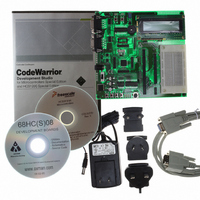M68EVB908GB60E Freescale Semiconductor, M68EVB908GB60E Datasheet - Page 226

M68EVB908GB60E
Manufacturer Part Number
M68EVB908GB60E
Description
BOARD EVAL FOR MC9S08GB60
Manufacturer
Freescale Semiconductor
Type
MCUr
Datasheet
1.M68EVB908GB60E.pdf
(290 pages)
Specifications of M68EVB908GB60E
Contents
Module and Misc Hardware
Processor To Be Evaluated
MC9S08GB
Data Bus Width
8 bit
Interface Type
RS-232
Silicon Manufacturer
Freescale
Core Architecture
HCS08
Core Sub-architecture
HCS08
Silicon Core Number
MC9S08
Silicon Family Name
S08GB
Kit Contents
GB60 Evaluation Kit
Rohs Compliant
Yes
For Use With/related Products
MC9S08GB60
Lead Free Status / RoHS Status
Lead free / RoHS Compliant
- Current page: 226 of 290
- Download datasheet (2Mb)
Analog-to-Digital Converter (ATD) Module
14.3.3
The analog input multiplexer selects one of the eight external analog input channels to generate an analog
sample. The analog input multiplexer includes negative stress protection circuitry which prevents
cross-talk between channels when the applied input potentials are within specification. Only analog input
signals within the potential range of V
conversions.
14.3.4
Figure 14-4
voltage in millivolts. The vertical axis the conversion result code. The ATD is specified with the following
figures of merit:
226
•
•
•
•
•
•
Number of bits (N) — The number of bits in the digitized output
Resolution (LSB) — The resolution of the ATD is the step size of the ideal transfer function. This
is also referred to as the ideal code width, or the difference between the transition voltages to a
given code and to the next code. This unit, known as 1LSB, is equal to
Inherent quantization error (E
straight-line transfer function into the quantized ideal transfer function with 2
± 1/2 LSB.
Differential non-linearity (DNL) — This is the difference between the current code width and the
ideal code width (1LSB). The current code width is the difference in the transition voltages to the
current code and to the next code. A negative DNL means the transfer function spends less time at
the current code than ideal; a positive DNL, more. The DNL cannot be less than –1.0; a DNL of
greater than 1.0 reduces the effective number of bits by 1.
Integral non-linearity (INL) — This is the difference between the transition voltage to the current
code and the transition to the corresponding code on the adjusted transfer curve. INL is a measure
of how straight the line is (how far it deviates from a straight line). The adjusted ideal transition
voltage is:
Zero scale error (E
and the ideal transition to that code. Normally, it is defined as the difference between the actual and
ideal transition to code $001, but in some cases the first transition may be to a higher code. The
ideal transition to any code is:
Adjusted Ideal Trans. V =
Analog Input Multiplexer
ATD Module Accuracy Definitions
illustrates an ideal ATD transfer function. The horizontal axis represents the ATD input
Ideal Transition V =
ZS
) — This is the difference between the transition voltage to the first valid code
1LSB = (V
MC9S08GB/GT Data Sheet, Rev. 2.3
Q
(Current Code - 1/2)
REFL
) — This is the error caused by the division of the perfect ideal
(Current Code - 1/2)
to V
REFH
2
REFH
N
– V
2
REFL
N
(ATD reference potentials) will result in valid ATD
) / 2
* ((V
N
REFH
*(V
REFH
+ E
FS
– V
) - (V
REFL
REFL
)
Freescale Semiconductor
N
steps. This error is
+ E
ZS
))
Eqn. 14-5
Eqn. 14-6
Eqn. 14-7
Related parts for M68EVB908GB60E
Image
Part Number
Description
Manufacturer
Datasheet
Request
R
Part Number:
Description:
Manufacturer:
Freescale Semiconductor, Inc
Datasheet:
Part Number:
Description:
Manufacturer:
Freescale Semiconductor, Inc
Datasheet:
Part Number:
Description:
Manufacturer:
Freescale Semiconductor, Inc
Datasheet:
Part Number:
Description:
Manufacturer:
Freescale Semiconductor, Inc
Datasheet:
Part Number:
Description:
Manufacturer:
Freescale Semiconductor, Inc
Datasheet:
Part Number:
Description:
Manufacturer:
Freescale Semiconductor, Inc
Datasheet:
Part Number:
Description:
Manufacturer:
Freescale Semiconductor, Inc
Datasheet:
Part Number:
Description:
Manufacturer:
Freescale Semiconductor, Inc
Datasheet:
Part Number:
Description:
Manufacturer:
Freescale Semiconductor, Inc
Datasheet:
Part Number:
Description:
Manufacturer:
Freescale Semiconductor, Inc
Datasheet:
Part Number:
Description:
Manufacturer:
Freescale Semiconductor, Inc
Datasheet:
Part Number:
Description:
Manufacturer:
Freescale Semiconductor, Inc
Datasheet:
Part Number:
Description:
Manufacturer:
Freescale Semiconductor, Inc
Datasheet:
Part Number:
Description:
Manufacturer:
Freescale Semiconductor, Inc
Datasheet:
Part Number:
Description:
Manufacturer:
Freescale Semiconductor, Inc
Datasheet:










